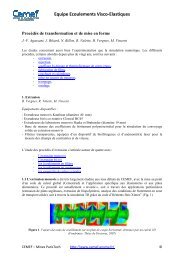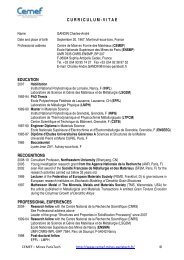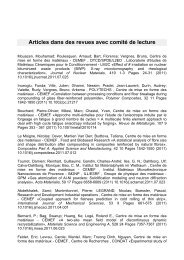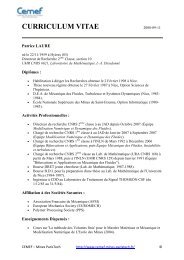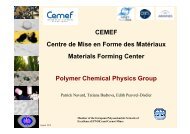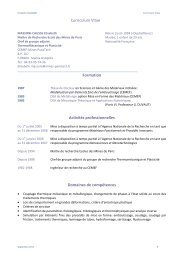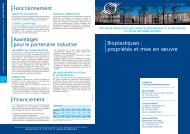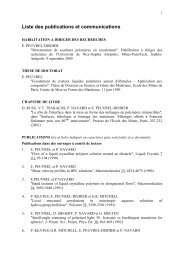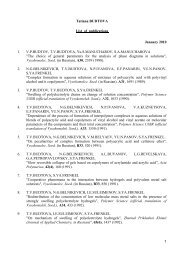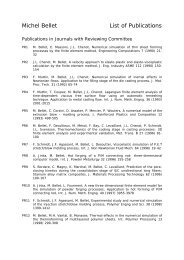(.pdf). - Cemef - MINES ParisTech
(.pdf). - Cemef - MINES ParisTech
(.pdf). - Cemef - MINES ParisTech
- No tags were found...
You also want an ePaper? Increase the reach of your titles
YUMPU automatically turns print PDFs into web optimized ePapers that Google loves.
gram to kilogram scalePolymer Processing PlatformProcessing - Modeling - Physics - Mechanics---------------------Centre for Materials Forming (CEMEF)Ecole des Mines de Paris – <strong>MINES</strong> <strong>ParisTech</strong>Centre de Mise en Forme des Matériaux / Materials Processing Center (CEMEF)Unité mixte de recherche CNRS 7635BP 207F-06904 Sophia AntipolisFranceVersion 3.1CEMEF http://www.cemef.mines‐paristech.fr/ ©
ContentGeneral context and objectives …………………………………… p 4Expertise of CEMEF ……………………..…… p 5Unique CEMEF tools……………………..…… p 6“g to kg scale Polymer Processing Platform” ..............…………… p 7List of recent and present research projects ………………….…. p 9Relevant publications 2010-2005 ………………..………………. p 10g to kg scale Polymer Processing Platform © CEMEF page 3 / 15
General context and objectivesDeveloping new polymers is nearly always starting with first stages where the amount of material isvery small. There is thus always a need in evaluating the usefulness of a given new polymer. Inaddition to the development of new oil-based polymers, the last years have seen a huge increase ofthe development of new biomass-based polymers, mainly associated with the consumer request ofhaving monomers and polymers from the renewable resource.Renewable carbon-based counterparts of existing oil-based polymers (polyesters, polyolefins, .;),new polymers coming from white biotechnologies (polylactic acid, polyhydroxyalcanoates,…), newcomplex polymerisation techniques, blends, mixtures with various organic and non-organic fillers,nano-suspensions, and new functionalisations are under development.The next years will see an even larger number of new polymers due to the predictable developmentof biotechnologies like new fermentation techniques, bacterial or sponge biosynthesis andmicroalgae culture.To fully characterise the new polymers, from physico-chemical and structural properties to theirprocessability and final end-use properties, there is the need to work with quantities of polymersfrom less than one gram up to several kilograms.The objective of CEMEF is to offer to polymer developers, chemists andbiotechnologists a complete platform of techniques and expertise enabling them toselect among a large number of low-amount potential candidates the ones that merit tobe produced in larger quantities.The “g to kg scale Polymer Processing Platform” combined with the wide polymer andbio-polymer expertise of CEMEF scientists and with CEMEF’s development ofadvanced numerical simulation techniques is the perfect and unique tool to successfullypropose innovative solutions in what concerns characterization of new polymers, toassess their processing ability, to develop and optimize their processing and to analyseand understand final material properties.CEMEF has a large experience in running research projects with industry, with more than 100active contracts each year involving post-doctoral scientists, PhD and Post-master.CEMEF is regularly coordinating consortium and large international programmes such as EuropeanR&D projects.CEMEF simulation expertise is industrialised through the development of commercial software, inparticular for polymer processing optimization.g to kg scale Polymer Processing Platform © CEMEF page 4 / 15
Expertise of CEMEFAR<strong>MINES</strong>-CEMEF (160 people including 70 PhD) is a joint academic research centre belonging to<strong>MINES</strong> <strong>ParisTech</strong>, CNRS and AR<strong>MINES</strong>. It is among the European leaders in the field of researchon material processing. It has been ranked A + by the French Research Ministry in 2008, the highestmark for a French research and education centre.The main expertises of CEMEF concern the developmentof innovative solutions in material physics thermodynamics and phase transformation mechanics modelling and numerical analysis computer engineeringMaterials physicsin static & dynamic conditionsThermomechanicsFriction, wear, surfacePhysical and mechanical modellingApplied mathematicsAnalysis and numerical simulationNew processes New materials New softwareResearch activities are centred on the physical and mechanical understanding of the principalaspects of materials processing and forming, through both experimental analysis and numericalsimulation. A large variety of materials are studied: synthetic and natural polymers, elastomers polymer blends, composites and nanocomposites food industry productsCEMEF focuses particularly on three research poles in order to optimize the whole processingchain:Knowledge of processes Experimental background for processing: measurements on pilot processes available atCEMEF or in industry Construction of instruments and pilot machines. Analysis of thermo-mechanical phenomena during processing (pressure, temperature, stresson materials) Understanding of the origin of defects, and correction Aid to optimise tool design and to solve scale-up problems.Knowledge of materials Rheology and behaviour during processing Processing-induced microstructures ,polymer and polymer/matrix composites organisationdevelopment Characterisation and modelling of end use mechanical properties; Development ofphysically based constitutive models and specific testing machines Physics, physical chemistry and mechanics of surfaces and interfaces. Optimisation of composites and nanocomposites and of structured materials Physics and physical chemistry of natural and synthetic polymers.Numerical simulation techniques Numerical simulation of thermomechanical flow and micro-structure evolutions duringforming Development of new computational methods: parallel computing, optimisation, fluidstructure interaction tools for studying thermal, mechanical and microstructure couplingbetween material flow and tools deformation.g to kg scale Polymer Processing Platform © CEMEF page 5 / 15
Dedicated software for polymer and polymer/matrix based composites: injection mouldingand extrusion (Rem3D © ), twin screw extrusion (Ludovic © ), extrusion and mixing (Ximex © ).Development of rheo-numerical tools for the comprehension and validation of phenomenaoccurring at the microstructure scaleUnique CEMEF toolsIn addition to recent, state -of-the-art pieces of equipment in physics, processing and mechanics,CEMEF developed specific, unique experimental and numerical tools to study polymers:Experimental facilities Capillary rheometers with controlled thermo-mechanical history Rheo-optical tools able to work with highly viscous polymers up to 180°C Dedicated small-angle light scattering software Crystallisation under microscope with shearing and stretching, with fast cooling Crystallisation under microscope under high pressure (200 MPa) Very high pressure polymer stamping (3GPa, available end of 2010) Extruders equipped with dies with transparent walls in order to observe the flow and tomeasure velocity (laser Doppler velocimetry) and stress fields (flow birefringence) Transparent mould installed on an injection moulding press Standard and non standard mechanical tests involving, video controlled systems, 3D strainfield and 2D temperature fields measurements, tension, shearing up to high strain rate. Home-developed thermo mechanical bi axial testing machineCEMEF large-scale computing toolsNumerical simulation provides informations on thermomechanical quantities and microstructureproperties at different scales.- At the process scale, simulations of extrusion or injection allows to access stress,temperature, deformation, deformation rates and most important, averaged properties givinginformation on the influence of the process on the structure development (such as averagemolecular or fiber orientation) and during the formation of the test samples.- At the microstructure scale, multiphase flow and mechanical computing provide data on thevalidity of the macroscopic behaviour and evolution laws.The many numerical techniques developed are highly parallelised, in order to be implemented inindustry.Highly parallel software facilitiesCEMEF’s has been investing for fifteen years in high performance computing, through thedevelopment of highly parallel software, but also by acquiring parallel computing architectures suchas clusters of PCs. Today’s configuration is composed of 1496 CPU processors and 960 GPUprocessors, distributed in the following way: 60 nodes of bi-processor Octo-Core 2,3GHz with 32Gb RAM, 22 nodes of bi-processor Dual-Core 2,4GHz with 8 Gb RAM, 24 nodes of bi-processorDual-Core 2,8GHz with 8 Gb RAM, 40 nodes of bi-processor Quad-Core 2,3GHz with 16 GbRAM, 2 nodes of bi-processor Octo-Core 2,3GHz with 32 Gb RAM linked to the 4 node GPU ofand 240 Cores with 16 Gb RAM.g to kg scale Polymer Processing Platform © CEMEF page 6 / 15
“g to kg scale Polymer Processing Platform”The purpose of the polymer processing platform is to perform a set of physical and mechanicalcharacterizations and of processing techniques able to guide companies in their development of newpolymers.The platform is based on four sub-platforms, each tailored for a specific given amount of polymers.5 g of polymer and lessWith such a low amount of polymer, especially when it is less than one gram, there is no possibilityto perform a classical processing in form of test (bar or film).The approach is to use complementary physical tools to be able to measure the processing range, tocharacterize the main physical transformations that the polymer can experience in a giventemperature range and the associated morphology (ies) and to estimate mechanical properties: State-of-the art calorimetry (<strong>Cemef</strong> is an application laboratory of ThermoFisher):thermodynamics, phase transition temperatures Optical and electron microscopies, X ray scattering: morphologies at levels from millimetersto nanometers. State-of-the-art SEM In-situ crystallization and structure development apparatus: optical, X ray and lightscattering characterizations of structures and kinetics Melt or solution rheometry: flow behaviour. <strong>Cemef</strong> is a leading research center in polymerrheologyDynamic mechanical analysis: mechanical relaxationsAtomic Force Microscopy with a nanoindentor (under air, in liquid environment withsolvents, acid and strong basis, between -5°C et +250°C, with small or large motoriseddisplacements): mechanical behaviour, surface structureChemical analysis (Time of flight mass spectrometry, XPS, FTIR)This first level gives an estimate of the potential usefulness of a given polymer.10 to 50 g of polymersProcessingAt this scale, it is now possible to process small amounts of polymers and to perform somecompounding and prepare test bars and films:Haake Minilab: twin screw extrusion, either co- or counter-rotating, with recirculation.Haake Minijet injection molding: coupled to Minilab, allows to inject test bar (traction,DMA) and disksThe whole Haake system allows to process neat polymers, polymer blends and suspensions withlow dimension fillers.Physics and mechanics Rheology: five rheometers are allowing performing capillary, cone-plate, plate-plate andextensional experiments in a variety of controlled environments (temperature, hygrometry,..) and solicitations (transient, dynamic and steady state shear). Structure: full characterisation of structures (X-ray, optical and electron microscopies, AFM,etc…) Flow-induced structures: Compounds can be studied by <strong>Cemef</strong>-made optical shear devicesto assess the stability of obtained morphologies under shear deformations.g to kg scale Polymer Processing Platform © CEMEF page 7 / 15
Standard mechanical tests (tension, compression, bending, toughness, hardness, …). Non standard mechanical tests (shearing, bi axial tension, high velocity tension /compression) and field measurements facilities.This second level allows having a reasonable estimate of the processability of a given polymer andgives a first idea of the polymer structure-processing-property relationship.100 g to 5 kg of polymersProcessing High precision injection molding press able to inject sample from 1 to 10 g from 100-200 gfeeding (available in 2011) Internal mixer Haake Rheomix 600P: compounding, blending, mixing Twin screw extruder ThermoFisher PTW24, with two gravimetric, one volumetric feedersand a pelletizer Single screw extruder Brabender with film blowing line Single screw extruder Haake with cast-film lineFor transparent products, the single screw extruders can be equipped with dies with transparentwalls in order to observe the flow and to perform measurements of velocity field (laser Dopplervelocimetry) and stress field (flow birefringence). Film-stretching machine (uni constant width and biaxial, sequential or simultaneous)Physics and mechanicsAs for 10 to 50 g of polymers. For rheological tests, two capillary rheometers can also be used, onewith a controlled pre-shear (Rheoplast©).This step allows to screen polymer characteristics (molar mass, branching, composition …) and toperform the first study of the structure-processing-property relationship.5 kg to 50 kg of polymersThis step allows a full characterization of both processing and structure-processing-properties insituations close to industrial conditions. Modelling is performed with industrial dedicated software.This step allows to perform scaling-up analysis to real industrial conditions.<strong>Cemef</strong> equipment is composed of: Twin screw extruder Clextral BC45, with one volumetric feeder Single screw extruder Kaufman (D = 40 mm) Injection moulding machine (DK 110 tons), mould with transparent windows Stretch-blow bottle moulderFor transparent products, the single screw extruder can be equipped with dies with transparent wallsin order to observe the flow and to perform measurements of velocity field (laser Dopplervelocimetry) and stress field (flow birefringence).Physics and mechanicsAs for 10 to 50 g of polymers.g to kg scale Polymer Processing Platform © CEMEF page 8 / 15
List of recent and present research projectsThe list below is a selection of research projects conducted with industry that are either on-going orthat finished less than two years ago.- Influence of shear on palm oil crystallisation.- Influence of pressure and cooling rate on polymer crystallisation.- Compounding of nanocomposites- Preparation of fibre reinforced composites (glass and natural fibres)- Micro-injection moulding- Calandering of multilayer structures- Extrusion of carbon pastes- Polymer blends containing biomass-based polymers.- Starch-based thermoplastic blends.- Natural fibre – thermoplastic composites.- Improvement of cellulose sponge properties.- Ultra-light cellulose foams: preparation, structures and properties.- Starch-polysaccharide blends as gelatine replacement for medical capsules.- Carbonized cellulose for electro-chemical applications.- Use of full plant for making composites.- Lignin-based materials.- Starch cationisation by reactive extrusion.- Extrusion of bitumen for nuclear applications- Dispersion of carbon black in polyamide for electrical conduction- Mechanisms of action of fluorinated processing aids- Modelling of dispersive and distributive mixing in extrusion processes- Experimental study of glass fiber reinforced composites processes: internal mixer, twinscrewextruder and continuous co-kneader- Influence of the calendering step on the adhesion properties of coextruded polymerstructures- Modelling of the foaming step of polyurethane- Experimental and numerical investigation of coextrusion instabilities- Rheometry of molten polymers at high shear rates- Developments on mini ( micro) injection moulding machines- Investigation of the behaviour of molten polymers in complex flow situations by FlowInduced Birefringence and Laser Doppler Velocimetry- Rheometry of hot-melt polymers- Influence of enzymatic and/or chemical treatments for increasing cellulose fiberprocessability.- Simulation of short fibre orientation development in injection moulding and prediction ofthe mechanical properties- Development of a fluid-structure interaction numerical technique to study the impactbehaviour of injection moulded polymers- Mechanical behaviour modelling of fibre reinforced thermoplastics- Development of innovative constitutive models for ISBM and thermoforming;- Development of new thermo mechanical approach for polymers in structural applications.g to kg scale Polymer Processing Platform © CEMEF page 9 / 15
- Numerical and experimental study of the water assisted injection moulding process- 3D compression and injection-compression moulding simulation- Numerical study of the “fluid buckling” during propergol injection moulding- Fibre and particle reinforced polymers rheo-numerical study- Representative Elementary Volume automatic generation and application to foam structuredevelopment modelling- Permeability computation of complex fabrics through a numerical dual scale approachRelevant publications 2010-20052010BOYER Séverine A.E., HAUDIN Jean-Marc, Crystallization of polymers at constant and high cooling rates: A newhot-stage microscopy set-up, Polym.Test., vol. 29, p. 445-452, 2010M. LEBOEUF, B. BRULÉ, N. GHAMRI, B. VERGNES, Correlation between rheological and electrical properties ofpolyamides filled with carbon black, Rheol.Acta, 49, 855-863 (2010)HAUDIN Jean-Marc, CARIN Aurélien, VINCENT Michel, AMOUROUX Nicolas, BELLET Gaëlle, MONTEZINFabrice, Relationships between processing conditions and mechanical properties of PA12 tubes. The EWF approach,Int. J. Mater. Form., 2010, DOI 10.1007/s12289-009-0673-8F. WENDLER, F. MEISTER, D. WAWRO, E. WESOLOWSKA, D. CIECHANSKA, B. SAAKE, J. PULS, N. LeMOIGNE, P. NAVARD, Polysaccharide Blend Fibres Shaped from NaOH, N-Methylmorpholine-N-oxide and 1-Ethyl-3-methylimidazolium acetate. Part I: Solutions, Fibre & Textiles in Eastern Europe, vol18, No. 2 (79) pp. 21-30 (2010)R.SESCOUSSE, K.A.LE, M.E.RIES, T.BUDTOVA, Viscosity of cellulose-imidazolium-based ionic liquid solutions,Journal of Physical Chemistry B, 114, 7222-7228 (2010).N. Le MOIGNE, K. JARDEBY et P. NAVARD, Structural changes and alkaline solubility of wood cellulose fibersafter enzymatic peeling treatment, Carbohydrate Polymers, 79, 325–332 (2010)M.DESSE, D.FRAISEAU, J.MITCHELL, T.BUDTOVA, Individual swollen starch granules under mechanical stress:evidence of deformation and volume loss, Soft Matter, 6, 363-369 (2010).L. VILLE, L. SILVA, T. COUPEZ, Improved Convective Level Set method for the numerical simulation of FluidBuckling; Int. J. for Num. Meth. in Fluids (2010)A. ANDRIYANA, N. BILLON, L. SILVA, Viscoelastic Characterization of Short Fibres Reinforced Thermoplastic inTension and Shearing; Applied Mechanics and Materials, v24-25 pp419-423 (2010)N. Le MOIGNE et P. NAVARD, Dissolution mechanisms of wood cellulose fibers in NaOH-water, Cellulose, 17, 31-45 (2010)N. Le MOIGNE, M SPINU, T. HEINZE et P. NAVARD, Restricted dissolution and derivatization capacities ofcellulose fibres under uniaxial elongational stress, Polymer, 51, 447-453 (2010)E.TARABUKINA, Z.ZOOLSHOEV, E.MELENEVSKAYA, T.BUDTOVA, Delivery of fullerene-containingcomplexes via microgel swelling and shear-induced release, International Journal of Pharmaceutics, 384 (1-2), 9-14(2010).N. LE MOIGNE, J. BIKARD, P. NAVARD, Contraction and rotation and contraction of native and regeneratedcellulose fibres upon swelling and dissolution: the role of stress unbalance, Cellulose, 17(3), 507-519 (2010)P.ROSENBERG, T.BUDTOVA, M.ROM, P.FARDIM, Effect of Enzymatic Treatment on Solubility of Cellulose in7.6%NaOH-water and Ionic Liquid, ACS book series, volume 1033 "Cellulose Solvents: For Analysis, Shaping andChemical Modification", Chapter 12, 2010g to kg scale Polymer Processing Platform © CEMEF page 10 / 15
A. MIJA, P. NAVARD, C. PEITI, D. BABOR, N. GUIGO Shear induced structuration of liquid crystalline epoxythermosets, Eur. Polym. J., (2010)2009ROZANSKI Artur, MONASSE Bernard, SZKUDLAREK Ewelina, PAWLAK Andrzej, PIORKOWSKA Ewa,GALESKI Andrzej, HAUDIN Jean-Marc, Shear-induced crystallization of isotactic polypropylene basednanocomposites with montmorillonite, Eur. Polym. J., vol. 45, p. 88-101, 2009BOYER Séverine A.E., GROLIER Jean-Pierre E., YOSHIDA Hirohisa, HAUDIN Jean-Marc, CHENOT Jean-Loup,Phase transitions of polymers over T and P ranges under various hydraulic fluids: Polymer/supercritical gas systemsand liquid to solid polymer transitions, J. Mol. Liquids, vol. 147, n° s 1-2, p. 24-29, 2009BOYER Séverine A.E., YAMADA Takeshi, YOSHIDA Hirohisa, GROLIER Jean-Pierre E., Modification of polymersmolecular organization by gas sorption. Thermodynamic aspects and industrial applications, Pure Appl. Chem., vol81, p. 1603-1614, 2009.O. BIGANSKA et P. NAVARD, Morphology of cellulose objects regenerated from cellulose–N-methylmorpholine N-oxide–water solutions, Cellulose 16(2), 179-188 (2009)E. TARABUKINA, F. JEGO, J.-M. HAUDIN, P. NAVARD et E. PEUVREL-DISDIER, Effect of shear on therheology and crystallisation of palm oil, J. Food Science, 74(8), E405-E416 (2009)SESCOUSSE R., BUDTOVA T., Influence of processing parameters on regeneration kinetics and morphology ofporous cellulose from cellulose-NaOH-water solutions, Cellulose, 16(3), 417-426 (2009).DESSE M., ANG S., MORRIS G.A., ABU-HARDAN M, WOLF B, HILL S., HARDING S., BUDTOVAT.,MITCHELL J.R., Analysis of the continuous phase of the modified waxy maize starch suspension, CarbohydratePolymers, 77, 320-325 (2009)GODARD F., VINCENT Michel, AGASSANT Jean-François, VERGNES Bruno, Rheological behaviour andmechanical properties of sawdust/polyethylene composites, J. Appl. Polym. Sci., 112, 2559-2566 (2009)DESSE M. MITCHELL J.R., WOLF B, HILL S., BUDTOVA T., Experimental study of the break-up of starchsuspension droplets in step-up shear flow, Journal of Rheology, 53, 943 (2009).VALETTE Rudy, COUPEZ Thierry, DAVID Chantal, VERGNES Bruno, A direct 3D numerical simulation code forextrusion and mixing processes, Int. Polym. Process., 24, 141-147 (2009)A. Allal, B. Vergnes, Molecular interpretation of the "stick-slip" defect of linear polymers, J. Non-Newt. FluidMech.,164, 1-8 (2009)S.Devisme, J.M.Haudin, J.F.Agassant, R.Combarieu, D.Rauline, F.Chopinez, Adhesion in polypropylene/aluminiumlaminates made by extrusion coating, J. Appl. Polym. Sci. 112, 2609-2624 (2009)R.Bouayad, J.Bikard, J.F.Agassant, Compressible flow in a plate/plate rheometer: application to the experimentaldetermination of reactive expansion’s models parameters for polyurethane foam, Int. J. Mat. Form., 4, 251-260 ( 2009)J.F.Agassant, A.Poitou, R.Valette, A kinematic approach to distributive mixing, In : Mixing and compounding ofpolymers, Edt Ica Manas-Zloczower, Carl Hanser Verlag,Munich (2009)L.Silva, J.F.Agassant, T.Coupez, Three-dimensional injection molding simulation. In : Injection molding, technologyand fundamentals, Edts M.R. Kamal, A.I. Isayev, S.J. Liu, Carl Hanser Verlag, Munich (2009)M. Vincent, Flow induced fiber micro-structure in injection molding of fiber reinforced materials. In : Injectionmolding, technology and fundamentals, Edts M.R. Kamal, A.I. Isayev, S.J. Liu, Carl Hanser Verlag, Munich (2009)2008HAUDIN Jean-Marc, SMIRNOVA Julia, SILVA Luisa, MONASSE Bernard, CHENOT Jean-Loup, Modelling ofstructure development during polymer processing, Polym. Sci., Ser. A, vol. 50, p. 538-549 2008, in Russian inVysokolmolekulyarnye Soedineniya, Ser. A, vol. 50, p. 827-840 (2008)g to kg scale Polymer Processing Platform © CEMEF page 11 / 15
HAUDIN Jean-Marc, CARIN Aurélien, PARANT Olivier, GUYOMARD Aurélie, VINCENT Michel, C. PEITIChristian, MONTEZIN Fabrice, A mechanical model for stress development in PA12 tube extrusion. Application tostructure development, Intern. Polym. Proc., vol. 23, p. 55-64 (2008)BOYER Séverine A.E., BABA Mohamed, NEDELEC Jean-Marie, GROLIER Jean-Pierre E., PolymersMicrostructures. Modifications and Characterization by Fluid Sorption, Int. J. Thermophys., 29, 1907-1920 (2008)GODARD F., VINCENT Michel, AGASSANT Jean-François, VERGNES Bruno, Etude du comportement rhéologiqueet des propriétés mécaniques de composites sciures de bois-polyéthylène haure densité, Rhéologie, 13, 9-21 (2008)GUILMINOT E., GAVILLON R, CHATENET M., BERTHON-FABRY S, RIGACCI A, BUDTOVA Tatiana, Newnanostructured carbons based on porous cellulose: elaboration, pyrolysis and subsequent use as substrate for protonexchange membrane fuel cell electrocatalyst particles, Journal of Power Sources, 185, 717-726 (2008)BIKARD Jérôme, COUPEZ Thierry, DELLA VALLE Guy, VERGNES Bruno, Simulation of bread making processusing a direct 3D numerical method at microscale. Analysis of foaming phase during proofing, J. Food Eng., 85, 259-267 (2008)HERTEL Daniela, VALETTE Rudy, MUENSTEDT Helmut, Three-dimensional entrance flow of a low densitypolyethylene (LDPE) and a linear low density polyethylene (LLDPE) into a slit die, J. Non-Newt. Fluid Mech., 153, 82-94 (2008)M. Leboeuf, N. Ghamri, B. Brulé, T. Coupez, B. Vergnes, Influence of mixing conditions on rheological behavior andelectrical conductivity of polyamide filled with carbon black, Rheol. Acta, 47, 201-212 (2008)A. Allal, B. Vergnes, Interprétation moléculaire du défaut de "stick-slip" des polymères linéaires, Rhéologie, 14, 44-55(2008)C. Sollogoub, E. Felder, Y. Demay, J.F. Agassant, P. Deparis, N. Mikler, Thermomechanical analysis and modelling ofthe extrusion coating process, Polym. Eng. Sci., 48, 1634-1648 (2008)BIGANSKA Olga, NAVARD Patrick, Morphology of cellulose objects regenerated from cellulose–NmethylmorpholineN-oxide–water solutions, Cellulose 16(2), 179-188, 2008GAVILLON Roxane, BUDTOVA Tatiana, Aerocellulose: new highly porous cellulose prepared from cellulose-NaOHaqueous solutions, Biomacromolecules, 9, 269-277 (2008)CHAUDEMANCHE Cyril, BUDTOVA Tatiana, Mixtures of pregelatinised maize starch and k-carrageenan:compatibility, rheology and gelation, Carbohydrate Polymers, 72, 579-589 (2008)2007A. Allal, B. Vergnes, G. Marin, Forme de la distribution des masses molaires pour supprimer le défaut de peau derequin, C. R. Physique, 8, 109-114 (2007)M. Leboeuf, N. Ghamri, B. Brulé, T. Coupez, B. Vergnes, Comportement rhéologique et conductivité électrique depolyamides chargés de noir de carbone, Rhéologie, 11, 35-44 (2007).VALETTE Rudy, BRUCHON Julien, DIGONNET Hugues, LAURE Patrice, LEBOEUF Mathilde, SILVA Luisa,VERGNES Bruno, COUPEZ Thierry, Méthodes d’interaction fluide-structure pour la simulation multi-échelles desprocédés de mélange, Méca. Indus., 8, 251-258 (2007)C. Combeaud, B. Vergnes, A. Merten, D. Hertel, H. Münstedt, Volume defects during extrusion of polystyreneinvestigated by flow induced birefringence and laser-Doppler velocimetry, J. Non-Newt. Fluid Mech., 145, 69-77(2007)A. Allal, B. Vergnes, Molecular design to eliminate sharkskin defect for linear polymers, J. Non-Newt. Fluid Mech.,146, 45-50 (2007)W. Lertwimolnun, B. Vergnes, Influence of screw profile and extrusion conditions on the microstructure ofpolypropylene/organoclay nanocomposites, Polym. Eng. Sci., 47, 2100-2109 (2007)G. Della Valle, B. Vergnes, D. Lourdin, Viscous properties of thermoplastic starches from different botanical origin,Intern. Polym. Proc., 22, 471-479 (2007)g to kg scale Polymer Processing Platform © CEMEF page 12 / 15
C. Dubrocq-Baritaud, N. Devaux, E. Darque-Ceretti, B. Vergnes, Mécanismes d’action des “Polymer Processing Aids”(PPA) dans l’élimination du défaut de peau de requin en extrusion, Rhéologie, 12, 19-26 (2007)DEVISME Samuel, HAUDIN Jean-Marc, AGASSANT Jean-François, RAULINE Damien, CHOPINEZ Fabrice,Numerical simulation of extrusion coating. Contribution to the understanding of adhesion mechanisms between graftedpolypropylene and aluminium, Intern. Polym. Proc., 22, 90-104 (2007)SMIRNOVA Julia, SILVA Luisa, MONASSE Bernard, HAUDIN Jean-Marc, CHENOT Jean-Loup, Identification ofcrystallization kinetics parameters by genetic algorithm in non-isothermal conditions, Eng. Comput., vol. 24, n° 5, p.486-513 , 2007EGAL Magali, BUDTOVA Tatiana, NAVARD Patrick, Structure of micro-crystalline cellulose-sodium hydroxideaqueous solutions below 0°C and the limit of cellulose dissolution, Biomacromolecules, vol. 8, p. 2282-2287, 2007GAVILLON Roxane, BUDTOVA Tatiana, Kinetics of cellulose regeneration from cellulose-NaOH-water gels andcomparison with cellulose-NMMO-water solutions, Biomacromolecules, vol. 8, p. 424-432 (2007)BERZIN Françoise, TARA Ahmed, TIGHZERT Lan, VERGNES Bruno, Computation of starch cationizationperformances by twin screw extrusion, Polym Eng Sci, vol. 47, p. 112-119 (2007)BERZIN Françoise, TARA Ahmed, VERGNES Bruno, Optimization and scale-up of thermoplastic wheat starchcationization in a twin screw extruder, Polym Eng Sci, vol. 47, p. 814-823(2007)W. Letwimolnun, B. Vergnes, G. Ausias, P.J. Carreau, Viscosity overshoots of organoclay nanocomposites in transientflow, J. Non-Newt. Fluid Mech., 141, 167-179 (2007)Digonnet, H.; Basset, O.; Silva, L.; Coupez, T ; Calcul parallèle appliqué aux écoulements de fluides complexes ;European Journal of Computational Mechanics, v16 pp 703-722 (2007).Laure, P.; Beaume, G.; Basset, O.; Silva, L.; Coupez, T.; Numerical methods for solid particles in particulate flowsimulations ; European Journal of Computational Mechanics, v16 pp 365-383 (2007).2006DUCOS Frank, BIGANSKA Olga, SCHUSTER Christian, NAVARD Patrick, Influence of the Lyocell fibre structureon their fibrillation, Cell Chem. Technol, vol. 40(5), p. 299-311, 2006F. Berzin, B. Vergnes, S.V. Canevarolo, A. V. Machado, J.A. Covas, , Evolution of peroxide-induced degradation ofpolypropylene along a twin-screw extruder: experimental data and theoretical predictions, J. Appl. Polym. Sci., 99,2082-2090 (2006)W. Lertwimolnun, B. Vergnes, Effect of processing conditions on the formation of polypropylene/organoclaynanocomposites in a twin screw extruder, Polym. Eng. Sci., 46, 314-323 (2006)A. Allal, A. Lavernhe, B. Vergnes, G. Marin, Relationships between molecular structure and sharkskin defect for linearpolymers, J. Non-Newt. Fluid Mech., 134, 127-135 (2006)B. Vergnes, F. Berzin, Modelling of reactive systems in twin screw extrusion: challenges and applications, C. R.Chimie, 9, 1409-1418 (2006)VALETTE Rudy, HERNANDEZ FERNANDEZ DEL CASTILLO Gabriella, MACKLEY Malcolm R., Matching timedependentpressure driven flows with a Rolie Poly numerical simulation, J. Non-Newt. Fluid Mech., 136, 118-125(2006)SOLLOGOUB Cyrille, DEMAY Yves, AGASSANT Jean-François, Non Isothermal Viscoelastic numerical model ofthe cast film process, J. Non Newt. Fluid Mech. 138, 76-86 (2006)AGASSANT J.F., ARDA D.R. , COMBEAU C., MERTEN A., MUENSTEDT H., MACKLEY M.R., ROBERT L.,VERGNES B., Polymer processing extrusion instabilities and methods for their elimination or minimisation, Intern.Polym. Proc. 21, 239-255 (2006)g to kg scale Polymer Processing Platform © CEMEF page 13 / 15
CARIN Aurélien, HAUDIN Jean-Marc, VINCENT Michel, MONASSE Bernard, BELLET Gaëlle, AMOUROUXNicolas, External calibration in PA12 tube extrusion. Understanding the influence of calibration on microstructure andsurface state to improve mechanical properties, Intern. Polym. Proc., 21, n° 1, 70-80 (2006)LE CLERC Christophe, BUNSELL Antony R., PIANT Anne, MONASSE Bernard, Role of skin/core structure andinclusions in the fatigue crack initiation and propagation in organic fibres, J. Mater. Sci., 41, n° 20, 6830-6842 (2006)PIORKOWSKA Ewa, GALESKI Andrzej, HAUDIN Jean-Marc, Critical assessment of overall crystallization kineticstheories and predictions, Prog. Polym. Sci., 31, 549-575 (2006)2005W. Lertwimolnun, B. Vergnes, Influence of compatibilizer and processing conditions on the dispersion of nanoclay in apolypropylene matrix, Polymer, 46, 3462-3471 (2005)A. Gaspar-Cunha, B. Vergnes, J.A. Covas, Defining the configuration of co-rotating twin-screw extruders with multiobjectiveevolutionary algorithms, Polym. Eng. Sci., 45, 1169-1173 (2005)J. Bikard, J. Bruchon, T. Coupez, B. Vergnes, Numerical prediction of the foam structure of polymeric materials bydirect 3D simulation of their expansion by chemical reaction based on a multidomain method, J. Mater. Sci., 40, 5875-5881 (2005)A. Allal, A. Lavernhe, B. Vergnes, G. Marin, Relation entre structure moléculaire et défaut de peau de requin pour lespolymères linéaires à l'état fondu, Rhéologie, 8, 31-43 (2005)BIGANSKA Olga, NAVARD Patrick, Kinetics of precipitation of cellulose from cellulose-NMMO-water solutions,Biomacromolecules, vol. 6, p. 1949-1953, 2005V. Collin, E. Peuvrel-Disdier, Dispersion mechanisms of carbon black in an elastomer matrix, Elastomery 9, 9-15(2005)C. SOLLOGOUB, Y. DEMAY, J.F. AGASSANT, Cast Film problem : a non isothermal investigation, Intern. Polym.Proc. 18, 80-86 (2005)R. VALETTE, P. LAURE, Y. DEMAY, J.F. AGASSANT, Investigation of the interfacial instabilities in thecoextrusion flow of PE and PS, Intern. Polym. Proc. 18 (2005)SILVA Luisa, GRUAU Cyril, AGASSANT Jean-François, COUPEZ Thierry, MAUFFREY Jocelyn., Advanced Finiteelement 3D Injection Molding, Intern. Polym. Proc., 20, 265-273 (2005)AGASSANT Jean-François, DEMAY Yves, SOLLOGOUB Cyrille, SILAGY David, Cast Film Extrusion, Intern.Polym. Proc., 20, 136-148 (2005)GAMACHE Eric, AGASSANT Jean-François, DEMAY Yves, LAFLEUR Pierre G., Evaluation of stresses in a twolayercoextruded LDPE melt blowing film, J. Plastic Film Sheet., 21, 127-144 (2005)M. Vincent, T. Giroud, A. Clarke, C. Eberhardt, Description and modeling of fiber orientation in injection molding offiber reinforced thermoplastics, Polymer, 46, p.6719-6725 (2005)SMIRNOVA Julia, SILVA Luisa, MONASSE Bernard, CHENOT Jean-Loup, HAUDIN Jean-Marc, Structuredevelopment in injection molding. A 3D simulation with a differential formulation of the kinetic equations, Intern.Polym. Proc., 20, n° 2, 178-185 (2005)PIORKOWSKA Ewa, BILLON Noëlle, HAUDIN Jean-Marc, GADZINOWSKA Krystyna, Spherulitic structuredevelopment during crystallization in confined space. 2. Effect of spherulite nucleation at borders, J. Appl. Polym. Sci.,97, 2319-2329 (2005)CARIN Aurélien, HAUDIN Jean-Marc, VINCENT Michel, MONASSE Bernard, BELLET Gaëlle, SILAGY David,External calibration in PA12 tube extrusion. I. On-line draw ratio measurement and lubrication estimate fordetermination of tensile properties, Intern. Polym. Proc., 20, n° 3, 296-304 (2005)CARIN Aurélien, HAUDIN Jean-Marc, VINCENT Michel, MONASSE Bernard, BELLET Gaëlle, AMOUROUXNicolas, External calibration in PA12 tube extrusion. II. Relations between molecular orientation, tensile propertiesand polymer drawing during calibration, Intern. Polym. Proc., 20, n° 3, 305-311 (2005)g to kg scale Polymer Processing Platform © CEMEF page 14 / 15
SMIRNOVA Julia, SILVA Luisa, MONASSE Bernard, HAUDIN Jean-Marc CHENOT Jean-Loup, Modelling ofcrystallization in injection molding. A 3D approach with a general formulation of the kinetic law, Intern. J. FormingProcesses, 8, SI, 219-239 (2005)Silva, L.; Gruau, C.; Agassant, J.-F.; Coupez, T.; Mauffrey, J.; Advanced Finite Element 3D Injection Molding;International Polymer Processing, v3 pp265-273 (2005).g to kg scale Polymer Processing Platform © CEMEF page 15 / 15



